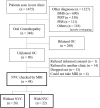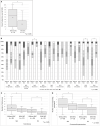Clinical Characteristics of Predominantly Unilateral Oral Cenesthopathy With and Without Neurovascular Contact
- PMID: 34616358
- PMCID: PMC8488299
- DOI: 10.3389/fneur.2021.744561
Clinical Characteristics of Predominantly Unilateral Oral Cenesthopathy With and Without Neurovascular Contact
Abstract
Oral cenesthopathy (OC) is characterized by unusual oral discomfort without corresponding evidence, and it has often been categorized as "delusional disorder, somatic type". Regarding possible causative factors of OC, involvement of neurovascular contact (NVC) of the trigeminal nerve, which transmits not only pain but also thermal, tactile, and pressure sensations, has never been observed yet. This study aimed to investigate the relationship between clinical characteristics of unilateral OC and the presence of trigeminal nerve NVC. This is a retrospective comparative study that involved 48 patients having predominantly unilateral OC who visited the Psychosomatic Dentistry Clinic of Tokyo Medical and Dental University between April 2016 and February 2019. Magnetic resonance imaging was performed to assess NVC presence. The Oral Dysesthesia Rating Scale (Oral DRS) was used to assess the various oral sensations and functional impairments besides psychometric questionnaires. Clinical characteristics were retrospectively obtained from the patients' medical charts. NVC was present in 45.8% (22/48) of the patients. There was no significant difference in sex, age, psychiatric history, oral psychosomatic comorbidity, and psychometric questionnaire scores between patients with and without NVC. However, compared to the patients with NVC, the patients without NVC had significantly higher scores for overall subjective severity of OC symptoms (p = 0.008). Moreover, patients having predominantly unilateral OC without NVC showed significantly higher scores in symptom severity and functional impairment of the following parameters: movement (p = 0.030), work (p = 0.004), and social activities (p = 0.010). In addition, compared with the patients with NVC, the patients without NVC showed significantly higher averages of the total symptom severity scale (SSS) and functional impairment scale (FIS) scores in the Oral DRS (p = 0.015 and p = 0.031, respectively). Furthermore, compared with the patients with NVC, the patients without NVC had significantly higher numbers of corresponding symptoms in both the SSS and FIS (p = 0.041 and p = 0.007, respectively). While NVC may be involved in the indescribable subtle OC symptoms, more complex mechanisms may also exist in OC patients without NVC, which yield varying and more unbearable oral symptoms.
Keywords: Oral DRS; burning mouth syndrome; delusional disorder somatic type; magnetic resonance imaging; neurovascular contact; oral cenesthopathy; trigeminal nerves; trigeminal neuralgia.
Copyright © 2021 Watanabe, Watanabe, Takao, Hong, Liu, Suga, Tu, Sakamoto, Umezaki, Yoshikawa, Takenoshita, Uezato, Motomura, Kurabayashi, Abiko and Toyofuku.
Conflict of interest statement
The authors declare that the research was conducted in the absence of any commercial or financial relationships that could be construed as a potential conflict of interest.
Figures



References
-
- American Psychiatric Association . Diagnostic and Statistical Manual of Mental Disorders. 5th ed.Boston, MA: Springer; (2013).
-
- World Health Organization . Classification of diseases (ICD). Available online at: http://www.who.int/classifications/icd/en/ (accessed May 01, 2021).
LinkOut - more resources
Full Text Sources
Miscellaneous

